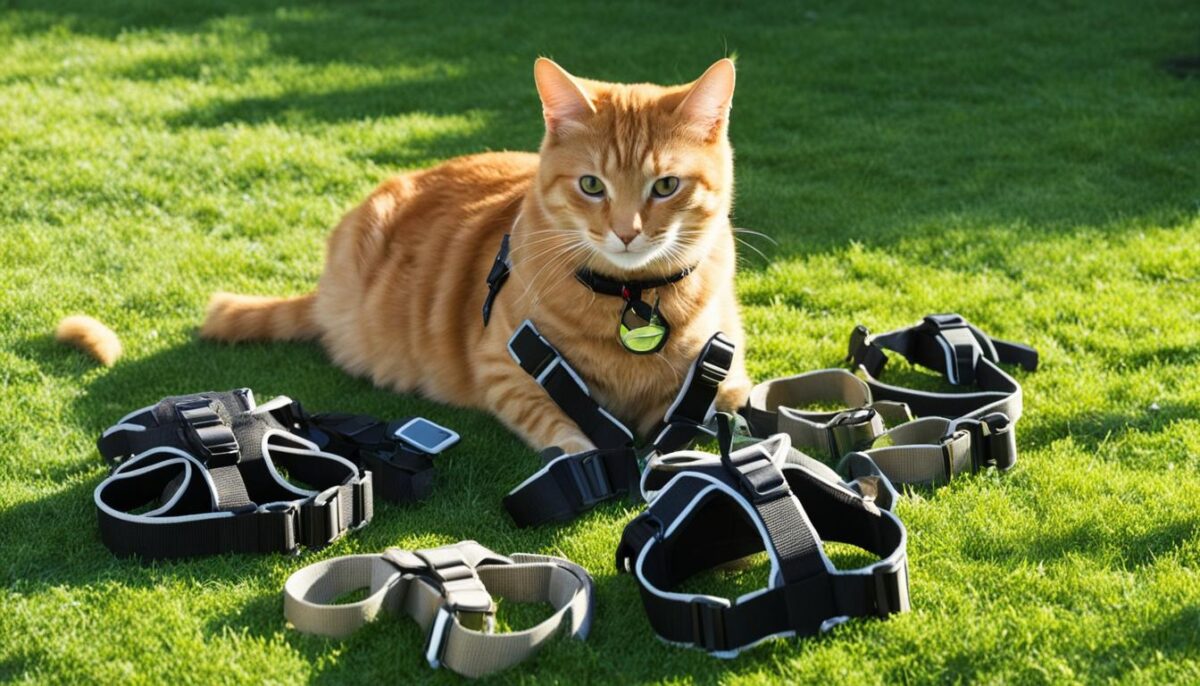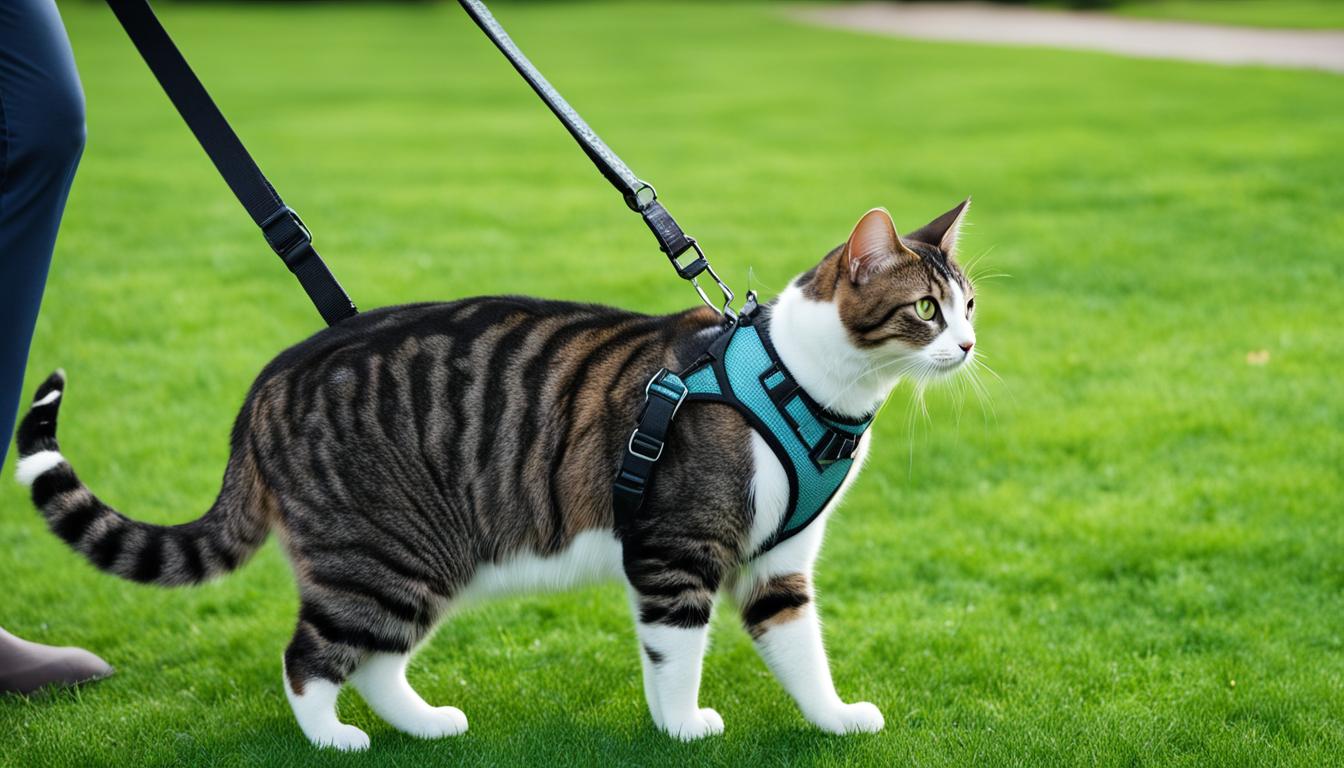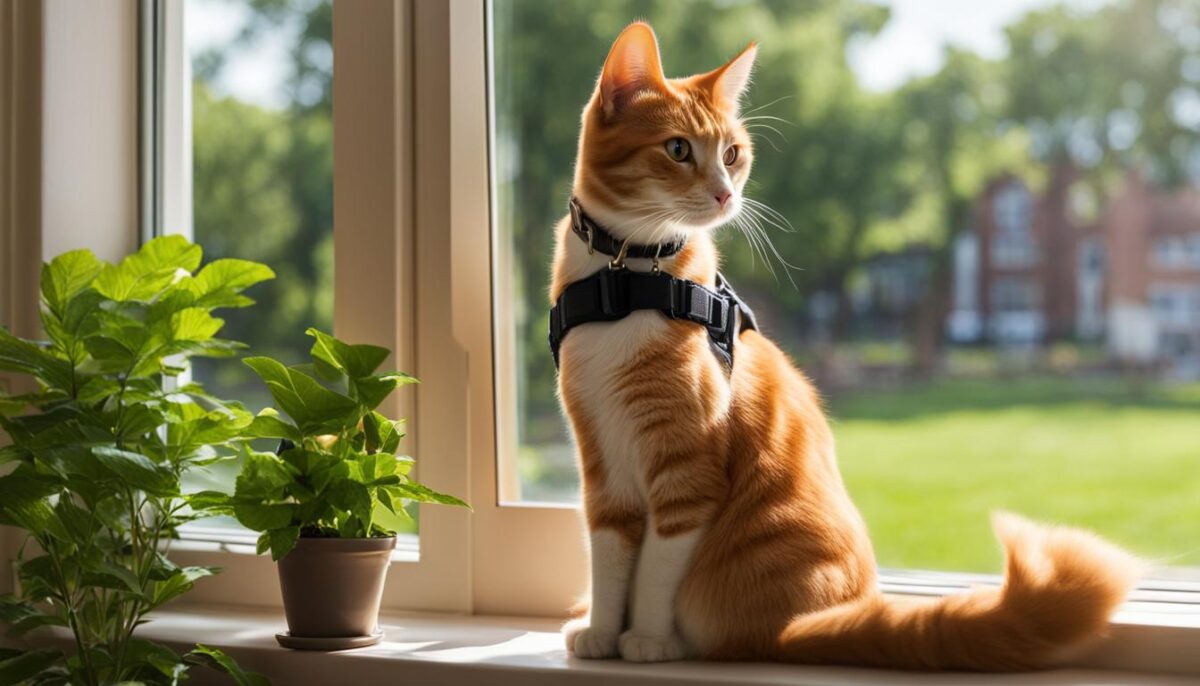Do you love taking your cat outside for adventures? With a cat harness, you can explore the outdoors together safely. Training your cat to wear a harness may seem hard, but don’t worry. It’s all about taking small steps and having fun. Before you start, remember that it’s not good for your cat to go outside without a harness. It can be dangerous. Also, a collar isn’t safe for walking cats. So, let’s get ready to enjoy some safe feline activities together!
Key Takeaways
- Start slow and keep training fun for your cat.
- A harness is better than a collar for safe walks.
- Don’t let your cat go outside alone without a harness.
- Outdoor time with your cat can make your bond stronger.
- Being patient is key to harness training success.
Introduction to Cat Harness Training
Starting a new adventure with your feline friend can be exciting! Whether you’re preparing for a feline outdoor adventure or just walking cats around the block, getting the right start with a harness is key. Cats, like people, have different feelings about new things. Some may jump right in, while others take a bit more time. That’s perfectly okay!
Let’s talk about a fun way to begin: behavior training for cats with a harness. First, let your kitty get a good sniff of the harness. It’s a strange new toy for them! When they show interest, give them a little treat. It’s like saying, “Good job for checking out this cool new thing!” They’ll start to think: “Hey, this harness means yummy treats and fun times!”
Here is what you can expect during this training phase:
- Letting your cat look at and smell the harness.
- Offering treats when they touch or sniff the harness.
- Doing these little things every day to make the harness a friend, not a foe.
Ready for some visuals? Here’s what happy harness training looks like:
After a while, your cat may think, “Oh, it’s that thing that gets me treats!” They’ll start getting super excited when they see the harness. It’s all about making them feel that wearing the harness is the start of something awesome. Soon, you’ll both be ready for some amazing walks and lots of exploring outdoors.
Remember, the most important part is to be patient and keep it fun. With each little step, you’re helping your cat learn and grow. And that’s what makes for an amazing outdoor adventure pal!
Choosing the Right Harness for Your Feline Friend
When you want to take your kitty outside, picking the right harness is super important. A good harness keeps your cat safe and comfy. Let’s talk about the different kinds you can choose from and how to make sure they fit just right.
Different Styles and Their Benefits
Roman harness: This type of harness looks a bit like a ‘H’ on your cat. It has two loops, one around the neck and one around the body, connected by a strap. The Roman harness is great because it’s adjustable and really secure for wiggly cats.
Step-in harness: This harness lies flat on the ground, and your cat steps into it before you buckle it up around them. It’s a good choice because it’s very easy to put on, even if your kitty isn’t too fond of getting dressed up.
Walking vest: Vests cover more of your cat’s body. This is nice because it spreads out the pressure, so there’s less pull on your cat’s neck. It’s comfy, like a snug shirt, and also very stylish.

Ensuring the Perfect Fit for Safety and Comfort
Your cat’s harness should fit just right – not too tight and not too loose. A secure cat harness means your furry friend can’t slip out and get lost, but it’s also not so tight that it would be uncomfortable. Make sure you can slip one or two fingers between your cat and the harness for the proper harness fit.
Let’s check out how different harnesses measure up!
| Harness Type | Adjustable | Coverage | Security Level |
|---|---|---|---|
| Roman harness | Yes | Medium | High |
| Step-in harness | Yes | Low | Medium |
| Walking vest | Sometimes | High | Very High |
Remember, a good adjustable cat harness will let you change the size so it’s just perfect for your kitty. Now you know all about choosing cat harnesses, you can pick the one that’s best for your cat, and go on fun, safe adventures together!
Prepping Your Cat for Harness Wearing
Are you ready to help your kitty get used to their new harness? Let’s make it a fun thing for them! With some **treats** and **patience**, you can turn harness time into a game that your cat will love.
Gradual Introduction to the Harness
First things first, let your cat sniff and see the harness. Place it near them and let curiosity do the rest. Next, gently touch your cat with the harness so they know it’s nothing to worry about. You can lay it on their back, too. Remember to give your cat a treat to make this a good time for them. Slowly, they’ll start seeing the harness as a friend.
Positive Reinforcement Is Key
As you help your cat get used to the harness, always use happy words and give them some yummy treats. This is called positive reinforcement. By doing this, wearing the harness becomes something they’ll look forward to because they associate it with good times and tasty snacks. Keep the mood light and fun, offering plenty of praise and rewards along the way.
Here’s a simple table to help you remember the steps:
| Step | Action | Rewards |
|---|---|---|
| 1 | Show the harness | Give treats for sniffing |
| 2 | Touch with the harness | Treats for staying calm |
| 3 | Place on back | More treats! |
| 4 | Fasten harness | Praise and treats |
By following these steps and using acclimating cats to harness, **harness training progression**, **cat harness training rewards**, **treat-based training**, and **positive cat reinforcement**, you will set the stage for many fun adventures with your feline friend. Take it slow, be encouraging, and watch as your cat becomes a pro at wearing their harness!
Cat Harness Training Steps
Training your cat to wear a harness is a journey you will both enjoy. Let’s walk through each step-by-step cat training phase together with lots of patience in training. You’ll see, soon your cat will be ready for harness wearing practice!
First, let your cat get used to the new harness by letting them sniff it. You can place it near where they sleep or eat. Next, gently put the harness on your kitty without fastening it. Give them a treat to make this a happy time! Then, when they seem okay with this, you can slowly fasten the harness while giving them another treat.
As your cat gets more comfortable, let them wear the harness longer. Watch how they walk and play while wearing it. Remember to always keep an eye on them, and take the harness off when you’re not around.
It’s fun to see your furry friend doing so well with their harness. They might walk in funny ways or shake a bit at first, but this is normal. Keep giving treats and saying nice things to show them they’re doing great.
Here’s a simple list to help you remember the training steps:
- Let your cat look at and smell the harness.
- Place the harness on your cat without fastening it – treat time!
- Fasten the harness slowly while your kitty eats more treats.
- Keep the harness on longer as your cat gets used to it.
- Play with your cat while they wear the harness.
- Always watch your cat in their harness, take it off when alone.
Before you know it, your cat will be all set to explore safely outside with you. Remember, it’s about going slow and making sure your cat feels safe and happy. Happy harness training!
Advance to Leash Training Indoors
Now that your cat is comfy in their harness, it’s time for some fun with leash attachment training! Begin this new adventure by letting your kitty check out the leash on their own. Let it lie on the floor and watch their curiosity kick in. Next up, hook it up while you both are inside—and don’t forget to keep things light and fun!
When you’re picking out a leash, think of a feather. You want something super light. Steer clear of the heavy stuff like chains or those roll-up leashes—those can be too much for a little cat. With the perfect cat leash types selected, let your fuzzy friend feel the leash’s gentle tug while they wear their harness indoors. They might wander around as if they’re exploring a new jungle!
Getting Comfortable with Leash Attachments
Your feline friend needs to get to know their leash. So, let’s attach it and watch them roam their indoor kingdom. Keep a close eye on them to make sure they’re always safe. This part is all about letting them feel free—even with a leash!
Cat’s Response to Leash Guidance and Tension
Got your cat wearing the leash? Awesome! Now you can follow them around. Keep the leash slack. As they get the hang of it, you can start leading them gently. They’ll learn how to follow your cues—almost like a dance! Treats help, of course. Got a treat? Use them to guide your kitty this way and that. This helps kitties learn about managing leash tension and guiding cats on leash. And that’s a big deal for indoor leash walking.
Remember, whether it’s their first steps or they’re becoming pros, keep the mood happy. That way, your cat will turn into an indoor exploring champ in no time!
Conclusion
As we reach the end of our cat harness training guide, it’s vital to remember that training your cat takes time and patience. You’re doing a wonderful job taking it one step at a time and making sure your cat feels safe and happy while learning. It’s okay if some days are a little harder and you need to go back and practice earlier steps. You both are on this journey together, and patience is your best friend in this training process.
Patience Leads to Harness Training Success
Like any fun skill, learning to walk on a harness doesn’t happen at once. Some cats might take a little longer, but that’s just fine! Every cat is special and learns in its own way. When you’re calm and patient, your cat can become a successful harness walker. This means no rushing or getting upset because taking it slow is the best path to success.
Nurturing the Bond with Outdoor Exploration
Think about all the wonderful times you can have outside with your cat once they’ve learned how to use a harness! From sunny walks in the park to just exploring the backyard, every little adventure helps build a stronger bond with your furry friend. Plus, it’s healthy for them too! It gives your cat a chance to play, see new things, and have an enriched, happy life. So keep up the good work – each small step today means lots of outdoor fun with your cat tomorrow!
FAQ
How do I start harness training my cat?
Begin by letting your cat sniff the harness and associating it with positive things like treats and praise. Gradually move to placing the harness on their back and then fastening it, continuing to reward them with treats and affection.
What type of harness is best for my cat?
Choose from styles such as Roman harnesses, step-in harnesses, and walking vests. The best option for your cat will depend on their size, comfort, and preference. Ensure it’s a secure cat harness and has a proper fit by using an adjustable cat harness.
How tight should the cat harness be?
The harness should be snug so that your cat can’t escape, but still allow you to fit one or two fingers between the harness and your cat’s body. This ensures safety and comfort during their outdoor exploration with cats.
How can I ensure my cat’s safety during harness training?
Always supervise your cat while they’re wearing the harness and never leave them unattended. Make sure the harness is properly adjusted and be patient with each training step to ensure a safe feline outdoor adventure.
Should I use a leash while training my cat to wear a harness?
Start by introducing the harness first. Once your cat is comfortable with it, integrate a lightweight leash suitable for cats into the training. Let them drag it around before progressively holding it and eventually guiding them on an indoor leash exploration.
What kind of leash is best for harness training?
Opt for a lightweight leash that’s easy for your cat to manage, avoiding heavy chain or retractable leashes that can be difficult for indoor leash walking with cats.
My cat is scared of the harness. What should I do?
If your cat is apprehensive, slow down the process and reinforce the positive association with treats and gentle petting. It’s okay to step back to a previous phase where your cat was comfortable and progress at a pace that suits them for a more successful cat harness training experience.
Can all cats learn to walk on a leash with a harness?
Most cats can learn to walk on a leash with patience, positive reinforcement, and consistency in training. However, every cat is unique, so harness training may not suit every feline’s temperament or interest in outdoor bonds with cats.
How do I get my cat used to the sound of the harness clips or Velcro?
Acclimate your cat to the noise by repeatedly using the clips or Velcro while offering treats. This helps create a non-threatening situation associated with positive experiences.
How often should I train my cat with the harness and for how long?
Short daily sessions are usually more effective than longer, infrequent ones. Start with a few minutes each day, gradually increasing as your cat becomes more comfortable for a successful cat harness training journey.

